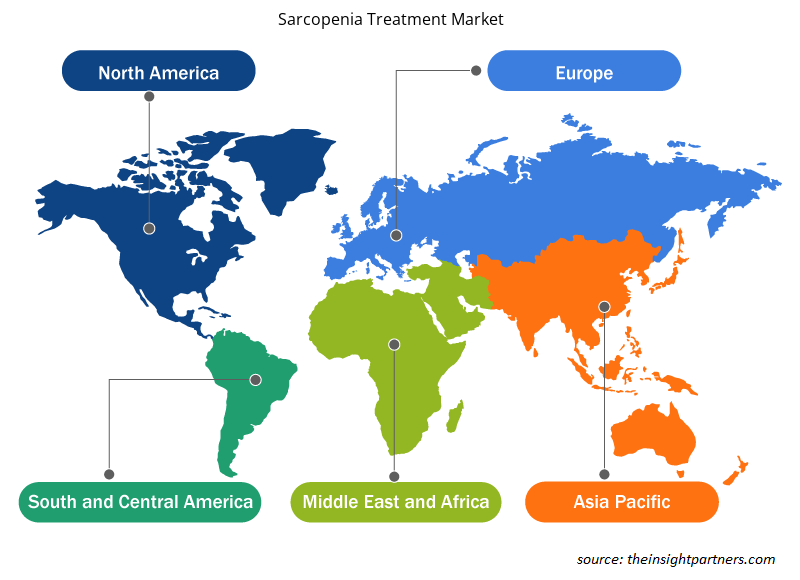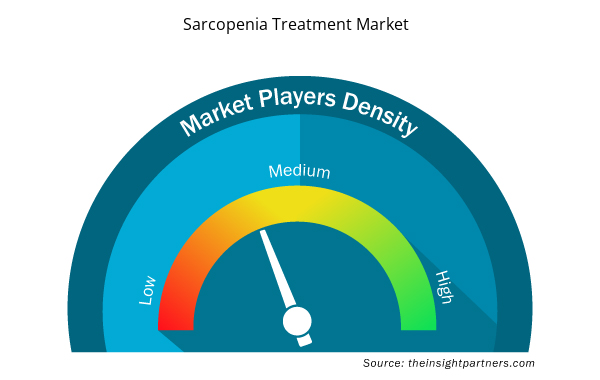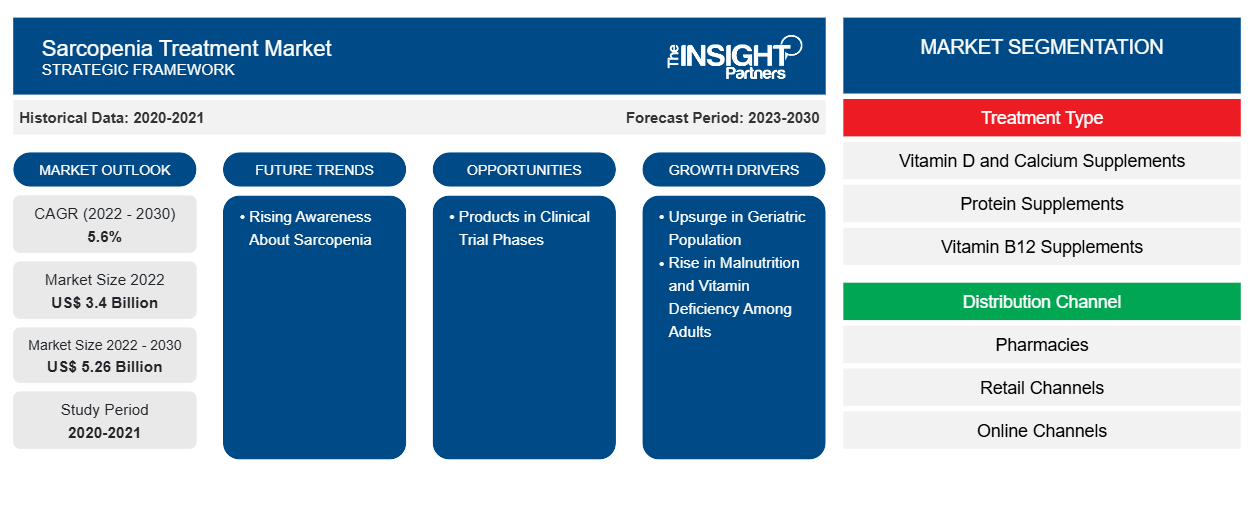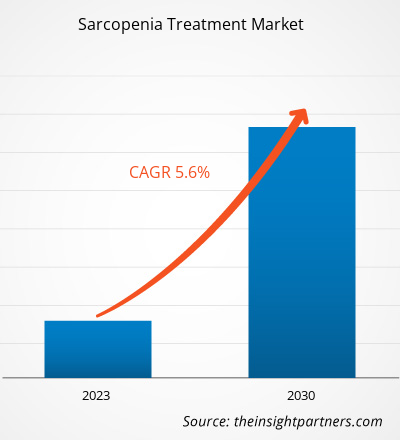[研究报告] 肌肉减少症治疗市场规模预计将从 2022 年的 33.9762 亿美元增长到 2030 年的 52.6476 亿美元;预计该市场在 2022-2030 年期间的复合年增长率为 5.6%。
市场洞察和分析师观点:
老年人口激增以及成人营养不良和维生素缺乏症的增加是推动市场增长的关键因素。然而,缺乏直接干预措施阻碍了肌肉减少症治疗市场的进展。营养不良是肌肉减少症的主要危险因素之一。根据世界卫生组织 (WHO) 的数据,截至 2021 年,全球约有 23 亿成年人营养不良,占全球人口的近 30%。在报告的风险因素中,蛋白质能量缺乏是肌肉减少症的常见原因。此外,维生素 D 缺乏或不足与多种疾病的风险增加呈正相关,例如癌症、肥胖症、心血管疾病和肌肉减少症。根据美国国立卫生研究院 (NIH) 的数据,全球近 50% 的人口患有维生素 D 不足,约 10 亿人缺乏维生素 D。在美国,超过 35% 的成年人患有维生素 D 缺乏症。
增长动力:
老年人口易患肌肉减少症、骨科疾病、代谢性疾病和神经系统疾病等。肌肉减少症是一种由骨骼肌质量和强度逐渐下降引起的老年病。它与不良健康后果的更高风险相关,例如跌倒、残疾、住院、生活质量差和死亡。发达国家的老年人口正在迅速增加。根据世界卫生组织 (WHO) 的数据,全球老龄人口可能会从 2019 年的约 10 亿增加到 2050 年的约 21 亿。根据美国国家医学图书馆的数据,中国老年人口的增长速度是世界上最快的国家之一。到 2040 年,预计中国 28% 的人口将超过 60 岁。根据日本的全国数据,该国 1.25 亿人口中有 29.1% 年龄在 65 岁或以上。根据2020年人口普查,1920年至2020年间,美国65岁及以上人口的增长速度约为总人口的5倍。2020年,老年人口数量达到5580万,占美国总人口的16.8%。
衰老导致肌肉质量下降,这是身体成分的主要变化之一。老年人的食物消费量大幅下降是导致肌肉质量下降的关键因素之一。根据美国国家医学图书馆的数据,50-60 岁年龄段的人每年会损失近 1.5% 的肌肉力量,而 60 岁以后每年会损失 1-2% 的肌肉质量。与一般人群相比,老年患者的肌肉减少症患病率更高。根据 2023 年 6 月在 Elsevier 上发表的一篇文章,肌肉减少症的患病率从糖尿病患者的 18% 到无法治愈的食道癌患者的 66% 不等。因此,老年人口的增加对肌肉减少症治疗市场的增长做出了重大贡献。
目前还没有一种获批的药物可以直接用于治疗肌肉减少症。这也可以归因于这样一个事实:最初有希望的治疗方法无法得到任何经过良好实施的随机对照试验的综合结果的支持。因此,缺乏直接针对肌肉减少症的治疗方案阻碍了肌肉减少症治疗市场的增长。
定制此报告以满足您的需求
您可以免费定制任何报告,包括本报告的部分内容、国家级分析、Excel 数据包,以及为初创企业和大学提供优惠和折扣
- 获取此报告的关键市场趋势。这个免费样品将包括数据分析,从市场趋势到估计和预测。
报告细分和范围:
肌肉减少症治疗市场已根据治疗类型和分销渠道进行细分。根据治疗类型,市场分为维生素 D 和钙补充剂、蛋白质补充剂、维生素 B12 补充剂和其他。根据分销渠道,肌肉减少症治疗市场分为药店、零售渠道、在线渠道和其他。根据地理位置,市场分为北美(美国、加拿大和墨西哥)、欧洲(法国、德国、意大利、英国、西班牙和欧洲其他地区)、亚太地区(澳大利亚、中国、日本、印度、韩国和亚太其他地区)、中东和非洲(沙特阿拉伯、阿联酋、南非和中东和非洲其他地区)以及南美洲和中美洲(巴西、阿根廷、南美洲和中美洲其他地区)。
节段分析:
根据治疗类型,肌肉减少症治疗市场分为维生素 D 和钙补充剂、蛋白质补充剂、维生素 B12 补充剂等。维生素 D 和钙补充剂部分在 2022 年占据了最大的市场份额。预计该细分市场的肌肉减少症治疗市场在 2022-2030 年期间的复合年增长率最高,为 6.5%。维生素 D 是一种脂溶性维生素,对维持钙稳态和健康的骨骼代谢至关重要。维生素 D 补充剂已被研究作为一种有用的饮食策略来降低肌肉减少症的风险。维生素 D 水平不佳的老年人极易患上肌肉减少症,通常与跌倒、住院和其他不良反应有关。
按分销渠道划分,肌肉减少症治疗市场分为药店、零售渠道、在线渠道和其他渠道。药店部分在 2022 年占据了相当大的市场份额。然而,预计在线渠道部分在 2022-2030 年期间的复合年增长率将达到 6.4%,是最快的。补充剂在药店作为非处方药出售。市场上有许多由各种膳食补充剂(如维生素 D、维生素 B12 和蛋白质补充剂)组成的非处方产品,这些产品是肌肉减少症治疗方案的一部分。
无现金交易是在线零售商发展的主要优势,有助于他们扩大在非大都市的覆盖范围。销售肌肉减少症治疗补充剂产品的几个主要在线渠道是阿波罗药房、HealthKart 和 1mg。互联网用户数量的增加、品牌的便捷访问、快节奏的生活方式、各种产品的全天候供应以及购物平台的高可访问性是推动肌肉减少症补充剂通过在线渠道销售的关键因素。
区域分析:
根据地域划分,全球肌肉减少症治疗市场分为北美、欧洲、亚太地区、南美和中美以及中东和非洲。2022 年,北美占据全球肌肉减少症治疗市场的最大份额。预计亚太地区在 2022-2030 年期间的复合年增长率最高。北美肌肉减少症治疗市场的增长归因于营养补充剂作为治疗选择的日益普及、骨科疾病患病率的激增以及老年人口中维生素 B12 和维生素 D缺乏症病例的增加。
北美的肌肉减少症治疗市场进一步细分为美国、加拿大和墨西哥。肌肉减少症的患病率因年龄和性别而异;在美国,居住在辅助生活设施或社区的老年人患上这种疾病的风险更高。根据美国国立卫生研究院的数据,2019 年美国肌肉减少症患者的预期住院费用为 404 亿美元。平均而言,患有这种疾病的人每年的住院费用比肌肉质量和功能正常的人高出 2,315 美元;他们住院的可能性几乎是没有肌肉减少症的人的两倍。研究表明,骨骼肌强度损失减少至少 10% 可以预防肌肉减少症,并每年为美国节省约 10 亿美元的医疗费用。
加拿大是增长最快的肌肉减少症治疗市场之一。该国市场的增长显而易见,每年报告的骨科疾病病例数量庞大,主要原因是维生素和营养缺乏。根据加拿大公共卫生署 (PHAC) 的统计,加拿大有超过 230 万人患有骨质疏松症。肌肉减少症是骨质疏松症的重要原因之一。骨质疏松症是导致 50 岁及以上人群 80% 以上骨折的主要风险因素。维生素、钙和蛋白质在预防和治疗肌肉减少症方面发挥着重要作用。关于补充剂对骨骼健康益处的持续研究以及营养保健品的进步预计将在未来几年在加拿大产生对肌肉减少症治疗的巨大需求。
行业发展和未来机遇:
肌肉减少症治疗市场中的一些主要参与者越来越关注治疗肌肉减少症的药物开发。目前正在开发和测试新型肌肉减少症治疗方法。下面提到了其中一些产品:
肌肉减少症药物正在临床开发中
公司名称
|
干预措施
|
状况
|
临床试验阶段
|
雅培营养品 | 含 AN777 的医疗食品 口服营养配方 | 营养不良 肌肉减少症 | 第三阶段 |
纽迪西亚研究 | 膳食补充剂:增强型 ONS A 膳食补充剂:Bolus ONS B 膳食补充剂:Bolus ONS C 膳食补充剂:Bolus ONS D | 肌肉减少症 | 第一阶段 |
诺华制药 | 药物:Bimagrumab | 肌肉减少症 | 第二阶段 |
麦克马斯特大学 | 行为:减少步骤 | 肌肉减少症 | 第一阶段 |
代谢技术公司 | 膳食补充剂:安慰剂 药物:HMB Plus 维生素 D 行为:非运动 行为:锻炼 | 肌肉减少症 | 第一阶段 |
默克夏普公司 | 药物:比较器 MK-077 药物:对照安慰剂 | 肌肉减少症 | 第二阶段 |
Immunotec 公司 | 膳食补充剂:Immunocal 膳食补充剂:酪蛋白 | 衰老|肌肉减少症 | 第二阶段 |
杨利军 | 组合产品:3个月强化干预 | 肌肉减少症 | 第四阶段 |
再生元制药 | 药物:REGN1033(SAR391786) 药物:安慰剂 | 肌肉减少症 | 第二阶段 |
来源:公司网站和 Insight Partners 分析
因此,处于不同临床开发阶段的药物管线的扩大为肌肉减少症治疗市场的增长提供了重大机遇。
肌肉减少症治疗市场区域洞察
Insight Partners 的分析师已详细解释了预测期内影响肌肉减少症治疗市场的区域趋势和因素。本节还讨论了北美、欧洲、亚太地区、中东和非洲以及南美和中美洲的肌肉减少症治疗市场细分和地理位置。

- 获取肌肉减少症治疗市场的区域特定数据
肌肉减少症治疗市场报告范围
| 报告属性 | 细节 |
|---|---|
| 2022 年市场规模 | 34亿美元 |
| 2030 年市场规模 | 52.6亿美元 |
| 全球复合年增长率(2022 - 2030 年) | 5.6% |
| 史料 | 2020-2021 |
| 预测期 | 2023-2030 |
| 涵盖的领域 | 按治疗类型
|
| 覆盖地区和国家 | 北美
|
| 市场领导者和主要公司简介 |
|
市场参与者密度:了解其对商业动态的影响
肌肉减少症治疗市场正在快速增长,这得益于终端用户需求的不断增长,而这些需求又源于消费者偏好的不断变化、技术进步以及对产品优势的认识不断提高等因素。随着需求的增加,企业正在扩大其产品范围,进行创新以满足消费者的需求,并利用新兴趋势,从而进一步推动市场增长。
市场参与者密度是指在特定市场或行业内运营的企业或公司的分布情况。它表明在给定市场空间中,相对于其规模或总市场价值,有多少竞争对手(市场参与者)存在。
在肌肉减少症治疗市场运营的主要公司有:
- 雅培实验室
- 拜耳公司
- 麦特金尼斯有限责任公司
- 雀巢健康科学公司
- 诺华公司
免责声明:上面列出的公司没有按照任何特定顺序排列。

- 了解肌肉减少症治疗市场顶级关键参与者概览
竞争格局和重点公司:
雅培实验室、拜耳公司、Metagenics LLC、雀巢健康科学公司、诺华公司、辉瑞公司、赛诺菲公司、安利公司、葛兰素史克公司和 Makers Nutrition LLC 是肌肉减少症治疗市场的知名公司。这些公司专注于引进新技术、升级现有产品和扩大地理覆盖范围,以满足全球日益增长的消费者需求。
- 2023 年 10 月,Metagenics LLC 完成了对 Amipro Advanced Development Products 100% 股份的收购。多年来,Ampiro 一直是 Metagenics LLC 产品在南非的独家经销商。此次收购加强了该公司在该国的分销网络,进一步使其能够在所有主要的 EMEA 国家开展直接分销业务。
- 2023 年 9 月,Biophytis 获得美国食品药品监督管理局 (FDA) 的授权,在美国启动其 SARA-31 研究。这是肌肉减少症治疗专业领域的首个 3 期研究。
- 2022 年 9 月,雅培实验室的子公司雅培印度有限公司推出了新配方 Ensure with HMB。Ensure with HMB 的推出旨在为印度老年人口提供饮食支持。该产品采用特殊独家成分 β-羟基-β-甲基丁酸酯 (HMB) 配制而成,有助于抵消肌肉流失,恢复体力和能量。
- 2022 年 3 月,全球领先的运动营养和生活方式营养补充剂品牌提供商 MusclePharm Corporation 推出了新的乳清蛋白饮料,增加了即饮蛋白质类别,扩大了其产品组合。
- 历史分析(2 年)、基准年、预测(7 年)及复合年增长率
- PEST 和 SWOT 分析
- 市场规模价值/数量 - 全球、区域、国家
- 行业和竞争格局
- Excel 数据集



Report Coverage
Revenue forecast, Company Analysis, Industry landscape, Growth factors, and Trends

Segment Covered
This text is related
to segments covered.

Regional Scope
North America, Europe, Asia Pacific, Middle East & Africa, South & Central America

Country Scope
This text is related
to country scope.
常见问题
The progressive loss of muscular mass, strength, and function is known as sarcopenia. The illness, which is most common in the elderly, is said to be brought on by ageing. Sarcopenia can significantly lower the quality of life by making it harder to carry out daily activities. It may result in the need for long-term care.
Sarcopenia has an impact on the musculoskeletal system and is a significant contributor to fractures, falls, and an increase in frailty. Hospital stays and surgical procedures brought on by these illnesses raise the possibility of complications, including death. Hormone supplements can be used to build muscle and treat sarcopenia. However, there aren't any FDA-approved drugs available right now to treat sarcopenia.
The factors that are driving growth of the market are upsurge in geriatric population and rise in malnutrition and vitamin deficiency among adults.
The sarcopenia treatment market majorly consists of the players such as Abbott Laboratories, Bayer AG, Metagenics LLC, Nestle Health Science SA, Novartis AG, Pfizer Inc., Sanofi SA, Amway Corp, GSK Plc, and Makers Nutrition LLC among others.
US holds the largest market share in sarcopenia treatment market. Sarcopenia prevalence varies with age and gender; elderly people residing in assisted living facilities or communities in the US are at a higher risk of developing this condition. According to the National Institute of Health, in 2019, the anticipated hospitalization cost for persons with sarcopenia in the US was US$ 40.4 billion. People with sarcopenia pay US$ 2,315 more for hospital visits than people with normal muscle mass and function every year on average; they are almost twice as likely to be hospitalized than people without sarcopenia.
Asia Pacific is expected to be the fastest growing region in the sarcopenia treatment market. Asia is the world’s most populated continent with a rapidly aging population, and sarcopenia-related issues are becoming more prevalent in several Asian countries. Asians lead extremely different lifestyles and follow different dietary habits than people from the Western world. In Asia, sarcopenia in older individuals is more common in males (prevalence 9.6–22.1%) than females (prevalence 7.7–21.8%). Asian Working Group for Sarcopenia (AWGS) aims to promote sarcopenia research.
The sarcopenia treatment market, based on distribution channel, is segmented into pharmacies, retail channels, online channels, and others. The pharmacies segment held a substantial market share in 2022. However, the online channels segment is predicted to register the fastest CAGR during 2022–2030.
The sarcopenia treatment market, based on treatment type, is segmented into vitamin D and calcium supplements, protein supplements, vitamin B12 supplements, and others. The vitamin D and calcium supplements segment held the largest share of the market in 2022.
Trends and growth analysis reports related to Life Sciences : READ MORE..
The List of Companies - Sarcopenia Treatment Market
- Abbott Laboratories
- Bayer AG
- Metagenics LLC
- Nestle Health Science SA
- Novartis AG
- Pfizer Inc
- Sanofi SA
- Amway Corp
- GSK Plc
- Makers Nutrition LLC
The Insight Partners performs research in 4 major stages: Data Collection & Secondary Research, Primary Research, Data Analysis and Data Triangulation & Final Review.
- Data Collection and Secondary Research:
As a market research and consulting firm operating from a decade, we have published and advised several client across the globe. First step for any study will start with an assessment of currently available data and insights from existing reports. Further, historical and current market information is collected from Investor Presentations, Annual Reports, SEC Filings, etc., and other information related to company’s performance and market positioning are gathered from Paid Databases (Factiva, Hoovers, and Reuters) and various other publications available in public domain.
Several associations trade associates, technical forums, institutes, societies and organization are accessed to gain technical as well as market related insights through their publications such as research papers, blogs and press releases related to the studies are referred to get cues about the market. Further, white papers, journals, magazines, and other news articles published in last 3 years are scrutinized and analyzed to understand the current market trends.
- Primary Research:
The primarily interview analysis comprise of data obtained from industry participants interview and answers to survey questions gathered by in-house primary team.
For primary research, interviews are conducted with industry experts/CEOs/Marketing Managers/VPs/Subject Matter Experts from both demand and supply side to get a 360-degree view of the market. The primary team conducts several interviews based on the complexity of the markets to understand the various market trends and dynamics which makes research more credible and precise.
A typical research interview fulfils the following functions:
- Provides first-hand information on the market size, market trends, growth trends, competitive landscape, and outlook
- Validates and strengthens in-house secondary research findings
- Develops the analysis team’s expertise and market understanding
Primary research involves email interactions and telephone interviews for each market, category, segment, and sub-segment across geographies. The participants who typically take part in such a process include, but are not limited to:
- Industry participants: VPs, business development managers, market intelligence managers and national sales managers
- Outside experts: Valuation experts, research analysts and key opinion leaders specializing in the electronics and semiconductor industry.
Below is the breakup of our primary respondents by company, designation, and region:

Once we receive the confirmation from primary research sources or primary respondents, we finalize the base year market estimation and forecast the data as per the macroeconomic and microeconomic factors assessed during data collection.
- Data Analysis:
Once data is validated through both secondary as well as primary respondents, we finalize the market estimations by hypothesis formulation and factor analysis at regional and country level.
- Macro-Economic Factor Analysis:
We analyse macroeconomic indicators such the gross domestic product (GDP), increase in the demand for goods and services across industries, technological advancement, regional economic growth, governmental policies, the influence of COVID-19, PEST analysis, and other aspects. This analysis aids in setting benchmarks for various nations/regions and approximating market splits. Additionally, the general trend of the aforementioned components aid in determining the market's development possibilities.
- Country Level Data:
Various factors that are especially aligned to the country are taken into account to determine the market size for a certain area and country, including the presence of vendors, such as headquarters and offices, the country's GDP, demand patterns, and industry growth. To comprehend the market dynamics for the nation, a number of growth variables, inhibitors, application areas, and current market trends are researched. The aforementioned elements aid in determining the country's overall market's growth potential.
- Company Profile:
The “Table of Contents” is formulated by listing and analyzing more than 25 - 30 companies operating in the market ecosystem across geographies. However, we profile only 10 companies as a standard practice in our syndicate reports. These 10 companies comprise leading, emerging, and regional players. Nonetheless, our analysis is not restricted to the 10 listed companies, we also analyze other companies present in the market to develop a holistic view and understand the prevailing trends. The “Company Profiles” section in the report covers key facts, business description, products & services, financial information, SWOT analysis, and key developments. The financial information presented is extracted from the annual reports and official documents of the publicly listed companies. Upon collecting the information for the sections of respective companies, we verify them via various primary sources and then compile the data in respective company profiles. The company level information helps us in deriving the base number as well as in forecasting the market size.
- Developing Base Number:
Aggregation of sales statistics (2020-2022) and macro-economic factor, and other secondary and primary research insights are utilized to arrive at base number and related market shares for 2022. The data gaps are identified in this step and relevant market data is analyzed, collected from paid primary interviews or databases. On finalizing the base year market size, forecasts are developed on the basis of macro-economic, industry and market growth factors and company level analysis.
- Data Triangulation and Final Review:
The market findings and base year market size calculations are validated from supply as well as demand side. Demand side validations are based on macro-economic factor analysis and benchmarks for respective regions and countries. In case of supply side validations, revenues of major companies are estimated (in case not available) based on industry benchmark, approximate number of employees, product portfolio, and primary interviews revenues are gathered. Further revenue from target product/service segment is assessed to avoid overshooting of market statistics. In case of heavy deviations between supply and demand side values, all thes steps are repeated to achieve synchronization.
We follow an iterative model, wherein we share our research findings with Subject Matter Experts (SME’s) and Key Opinion Leaders (KOLs) until consensus view of the market is not formulated – this model negates any drastic deviation in the opinions of experts. Only validated and universally acceptable research findings are quoted in our reports.
We have important check points that we use to validate our research findings – which we call – data triangulation, where we validate the information, we generate from secondary sources with primary interviews and then we re-validate with our internal data bases and Subject matter experts. This comprehensive model enables us to deliver high quality, reliable data in shortest possible time.


 获取此报告的免费样本
获取此报告的免费样本